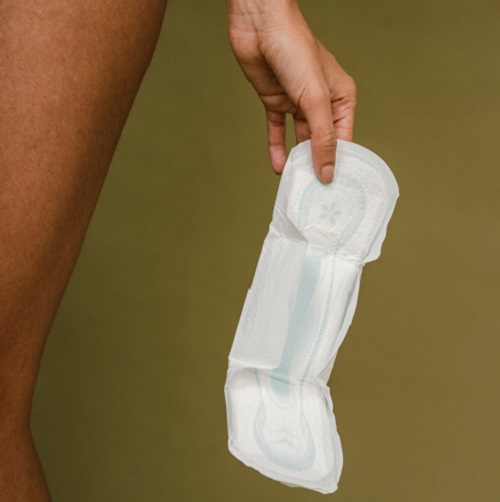Sanitary pads, tampons, and other menstrual hygiene products can be disposed of in several ways. One rule, though, as far as feminine hygiene products are concerned, is that they should never be flushed down the toilet. So, can you flush a pad down the toilet? The answer is no, and we’ll tell you why.
In this article, we’ll explore the effect of flushing sanitary pads down the toilet on your drains. We’ll also provide tips on how to dispose of used sanitary pads safely. Read on.
What Are Pads Made Of?
To understand why flushing a pad is not the right way to dispose of it, let’s take a look at what these hygiene products are made of. The typical sanitary pad is made from super-absorbent polymer capable of absorbing water up to 30 times its weight.
The absorbent nature of these products is attributable to the sodium salts (sodium polyacrylate) in the polymer. Do you know how pads cause rashes? That’s because of these absorbent properties. The sodium salts will also absorb moisture from the skin, resulting in rashes.
Did you know that sanitary pads can be up to 90% plastic? That’s about the same amount of plastic as five typical plastic shopping bags a pack of typical pads contains. Because it doesn’t dissolve in water, you can’t flush plastics down a toilet.
And it’s not just pads; most period products contain plastic. Tampons come in plastic packaging, enclosed in plastic applicators, and with plastic strings dangling from one end. Some brands even include a thin layer of plastic in the absorbent part.
Can You Flush a Pad Down the Toilet?
So, can you flush a pad down the toilet? No. As you can see from the previous section, sanitary pads are designed to absorb water, not break down in it. When you flush a pad, it’ll only expand and jam up the pipes in your bathroom plumbing.
The reason you shouldn’t flush pads and similar products down the toilet is that these items don’t disintegrate in the water. They expand when submerged, clogging your drain pipes and causing severe blockages in the sewer system.
Not to forget that sanitary products also contain plastic fibres, which can exacerbate the situation. Plastic is non-biodegradable and may cause clogs and blockages further down the line. As mentioned previously in the article, conventional pads can be up to 90% plastic.
When you flush a pad, these plastics can easily lodge on the inside of a pipe. The plastic can form the framework of a clog when it snags on the side of a pipe. They may be small, but these plastic bits can accumulate to create a much bigger problem in your plumbing.
If I Can Flush Toilet Paper, Why Not Pads?
Toilet paper is safe to flush down the toilet. The reason toilet paper is safe to flush down the toilet is that it breaks down in the water, given it’s only a few sheets at a time. However, too much toilet paper can also clog your toilet so keep that in mind.
Unlike toilet paper, sanitary pads don’t disintegrate when immersed in water. It’s quite the opposite; sanitary pads increase in size when submerged. A typical pad will grow to approximately ten times larger once it’s soaked up all the water it can.
Even if a pad seems small enough to be disposed down a drain, it can still cause issues in your bathroom plumbing or septic tank. Due to its absorbent properties, a pad will grow several times larger than its original size after being submerged.
Pads also contain plastic, another material that you shouldn’t be flushing down the toilet. Upon entering a drainage system, the plastics in sanitary pads can accumulate and form blockages in your home’s drainage system.
What Happens If I Flush a Pad Down the Toilet?
Pads and other hygiene products, such as tampons or wipes, should never be flushed in the toilet, even those that claim to be flush-friendly. The super-absorbent material will soak up all the water and clump together in your pipes, causing problems down the line.
Flushing a pad can cause clogs in your toilet. In the worst case, a flushed pad will cause your toilet to back up and overflow or create issues with your septic tank. Plumbers are always fishing out feminine hygiene products as the cause of clogs in the toilet drain pipes.
Granted, some flushed pads do go through the plumbing. Flushed sanitary products that travel through the sewerage systems create serious issues. Personal hygiene products that have been flushed down toilets can form solid waste in a sewerage system, causing severe blockages.
Even if a flushed pad doesn’t clog your drain pipes or cause blockage in the sewer system, it will still end up somewhere it shouldn’t be. If it’s not clogged in the sewer, it’s in the ocean. This type of waste pollutes the oceans on a mass scale and threatens marine life.
How To Safely Dispose of Used Sanitary Pads
As a thumb rule, menstrual hygiene products should never be flushed down the toilet because they may clog your drain pipes or cause issues with your septic tank. Now that we’ve established this very important rule, what’s the best way to dispose of sanitary pads?
Here are our top tips on how to dispose of sanitary pads safely and discreetly while being considerate of other bathroom users:
Have A Separate Bin for Used Sanitary Pads
The first step to properly dispose of used sanitary pads is to keep a separate bin for them. Soiled sanitary pads are biohazard waste. So, if you have separate cans for dry and wet trash, remember that used pads don’t belong in either.
Place a disposable lining inside this bin. This will ensure the local garbage collector doesn’t just dump the used sanitary pads into the collected waste and mix them with the rest of the trash. Ensure that the trash can you’re using to dump the sanitary pads has a lid.
Fold and Wrap Used Pads
Fold it and wrap a pad properly in toilet paper before disposing of it. You can also wrap your used pad in the wrapper of the new pad. Wrapping soiled pads ensures that they are adequately covered but keep away the smell, germs, and flies.
Some brands come with wrappers that feature a convenient tab closure on them for just this purpose. All you have to do is take your used pad, place it in the wrapper, roll it up, and secure it with the tab. Then put it in the trash can and wash your hands.
Opt for Eco-Friendly Alternatives
Conventional menstrual hygiene products have a highly negative environmental footprint. As mentioned earlier in the article, sanitary pads can contain up to 90% plastic, and plastic tampon applicators can take hundreds of years to break down.
Eventually, they break down into microplastics that pollute oceans and contaminate our water sources. Thankfully, there are eco-friendly alternatives to traditional tampons and plastic-packed pads that are as good for you as they are for the environment in the market.
Keeping menstrual hygiene products out of your toilet is better for the environment. If flushed sanitary pads don’t just clog your pipes, they can cause pollution, threatening marine life and damaging ocean ecosystems.
When it comes to discarding period pads, the most important thing is that you remember the golden rule — don’t flush it. The rest is largely up to you. Try to be more considerate of others using the same bathroom as yourself.
The Bottom Line
Flushing a pad is a big no, no. Pads are meant to absorb as much water as possible, not break down in it like toilet paper. You can accidentally create problems for yourself or your neighbors by flushing sanitary pads down your toilet.
The super-absorbent products will soak up all water and swell up after being submerged. When you flush a sanitary pad down the toilet, it can clog your drains, toilets, and septic and sewer lines. Even the smallest pad will end up being several times larger when flushed, causing problems down the line.
Once the pad expands in size after absorbing water, it can clog the toilet drain in your home or get caught up further down the plumbing system, causing severe sewer blockages. If you have your own septic tank, flushed sanitary pads can lead to a blockage and cause sewage to back up into your home.
Pads and other menstrual hygiene products should always be hygienically disposed of in the trash. Toss these items in your trash can to ensure they get to the landfill where they belong. Make it a rule in your home to never flush anything other than the toilet paper to avoid clogs, blockages, and other problems.



